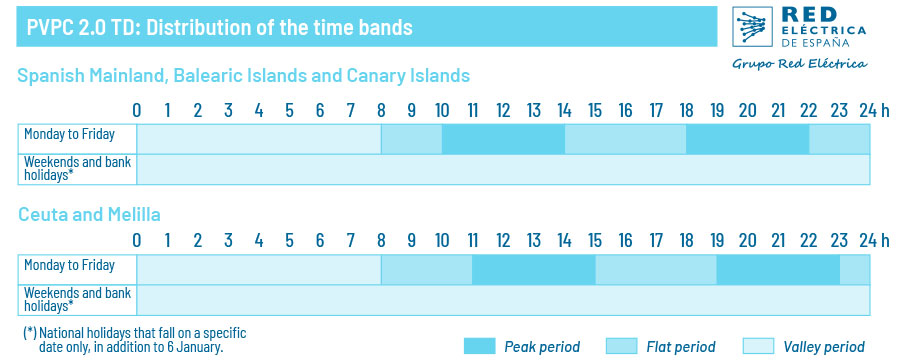We are a global operator of essential infrastructure
- The new curve which, as of tomorrow, 1 June, will replace the three existing price curves currently in use, will be published on the eSios website and on the redOS app developed by Red Eléctrica de España.
- With three differentiated consumption periods (peak, flat and valley), the new tariff will be published every day at 8.15 p.m. with the prices that will be applied the following day
- By consulting the price information provided by Red Eléctrica de España, consumers who have opted for the Voluntary Price for Small Consumers (PVPC) can decide which is the most attractive time period for their electricity consumption.
The operator of the Spanish electricity system, Red Eléctrica de España (REE), will publish every day at 8.15 p.m. on the eSios website and the redOS app the hourly electricity prices for the following day in accordance with and adapted to the new structure regarding tolls and charges that comes into force tomorrow, 1 June. These hourly prices will be applied to the energy consumed (real hourly consumption) on the electricity bill of consumers who have opted for the Voluntary Price for Small Consumers (PVPC).
The PVPC, in the 2.0 TD tariff, will replace the three tariffs that exist to date (the default tariff, 2.0 A; the two-period efficiency tariff, 2.0 DHA, and the electric vehicle tariff, 2.0 DHS) with a single price curve. This curve is based on hourly discrimination and is divided into different consumption periods (peak, flat and valley) in which the regulated tolls and charges applied varies according to the consumption period: e.g., higher tolls and charges in the peak period, intermediate toll and charge impact in the flat period and, lastly, the valley period which accounts for 53% of the hours of the year and where the impact of the regulated costs (tolls and charges) will be lower.
This hourly price curve for the small consumer is the result of the cost of energy production, payments for transmission and distribution tolls and the charges for the energy consumed.
The tariffs are applied to the hourly energy consumed on the electricity bill of consumers nationwide who have opted for the PVPC scheme, although in the case of the autonomous cities of Ceuta and Melilla, the applicable consumption time bands are displaced slightly.

Thus, Red Eléctrica de España will make this information available to consumers through the eSios website and the redOS app, an application for mobile devices launched by the Company in November and which enables monthly enquiries to be made regarding the new price and which is also broken down according to the three new different consumption periods. In addition, redOS can be used to customise alerts to warn the user when the price is above or below an indicated value set by the user.
Another new feature of the new PVPC 2.0 TD invoicing framework is that consumers can choose two different contracted power capacity levels depending on their consumption needs: one will be applied in the valley period and the other in the peak and flat periods.
With this new hourly discrimination tariff together with the detailed price information, consumers are directly involved in regulating and planning their electricity consumption in the most optimal way according to their needs.
Find more information about the PVPC here














